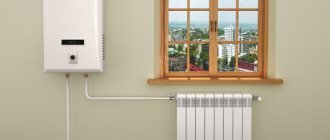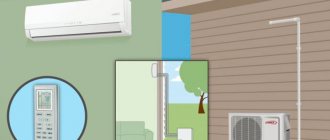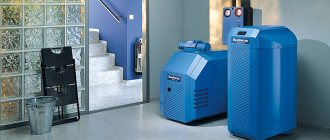Today we will talk to you about induction heating. Many are trying to present induction boilers as something innovative that will supposedly save us money and ensure the existence of our heating system. But what really?
In fact, induction boilers are units that are very expensive, bulky, inconvenient to use and not endowed with a sufficient number of properties and qualities that are necessary for the normal operation of a modern electric heating boiler.
Those people who invent these boilers and try to sell them to you do not tell the consumer anything about these aspects of their products, but only highlight positive qualities. Here we will display all the pros and cons of induction heating at home
What do induction heating manufacturers say?
Most often, manufacturers compare induction heating boilers with traditional ones, and traditional ones make up 99% of all electric boilers on the market.
Boilers are always compared according to this scheme: the imaginary shortcomings of heating element boilers and the positive qualities of induction heating at home are highlighted.
For example, the following indicators:
- Quite a lot of heating elements;
- That supposedly one or even several heating elements can fail;
- It is argued that the boiler may lose its working ability;
- They pay special attention to scale, which can appear as deposits directly on the very surface of the heating elements;
- The complexity and bulkiness of the design is due to the fairly large number of electrical contacts;
- The creators of induction boilers claim that their boilers last longer due to the fact that they can soften water;
- An absolutely unfounded and unfounded statement that periodic replacement of gaskets, heating elements and risters is required.
Principle of operation
The fundamental difference between such a stove and other types is that the cookware is heated not by an open flame (as in gas stoves) or a metal heating element (as in conventional electric stoves). Cookware on an induction hob is heated by the movement of electromagnetic currents passing through a magnetic coil under the glass-ceramic surface.
This operating principle allows us to draw the following conclusions.
Only cookware that has ferromagnetic properties will heat up. But this does not mean that you will need to buy something special. The old one may be fine.
How to check if a particular pot or pan is suitable? Bring a magnet to its bottom or look at the symbols. See the picture below for what the “induction” icon looks like.
Use pans with a flat bottom and no dents or bulges.
Only the part of the stove under which the pan is placed will heat up. The glass-ceramic surface of the stove is already heated by hot dishes, and if you remove a hot pan from it, it will quickly cool down in a few seconds. Thanks to this, there is less risk of getting burns (only if from hot dishes during cooking).
This feature of her work is very relevant for families with small children. Even if a child turns on the stove, it will not start to heat up unless there is a pan with a magnetic bottom on it.
Electricity is consumed more economically due to the narrowly targeted effect of heat, and food that gets on the surface does not burn.
The induction oven is easy to clean.
The dishes must be of a suitable diameter - at least 12 cm. This means that an accidentally forgotten fork or spoon on the stove will not heat up. Well, you will have to give up the usual little Turk. Instead, you can buy a special one or purchase an adapter - a metal disk of the diameter required for heating the stove.
Attention! When using an adapter disk, it is not recommended to turn on the equipment at full power. Watch an interesting video about the pros and cons:
Watch an interesting video about the pros and cons:
Criticism of incorrect heating boilers
They indicate that in a high-quality induction heating boiler there are no heating elements. Of course, this is not true, because without a heating element we would have nothing to heat the water with, that is, it is always present in any boiler!
In the vast majority of installed electric boilers, the heating element does not fail for almost the entire service life of the boiler.
If the heating element does fail, we can easily change it, since it is under a flange or on a thread. If suddenly an induction heating unit breaks down for no reason, then it is almost impossible to replace it.
Now about scale . It exists in a kettle, but in home heating systems it does not exist, because there the water does not boil at all, and deposits are always and everywhere present, in any system: on gas, diesel, wood, electric, heating element, electronic, induction boilers. It doesn't matter what kind of boiler it is. Sediment will always be present as it is sediment that is always present in the water. This is not a disadvantage or an advantage, but a given.
About electrical contacts. Manufacturers write that there are no electrical contacts in an induction heating boiler. But in fact, electrical contacts are always and everywhere. And if we talk about heating element boilers, then electrical contacts, stone terminals. have been absent there for many years. There are electrical contacts located under screw connections that do not require tightening, and there are spring clamps that are also not worth servicing.
Regarding the service life of the heating element and the figures justifying this life. It is not clear where these figures come from and how they are confirmed. In addition, here the authors confuse water supply and heating systems. There are not as many impurities in the heating system as there are in the water supply system. Softening the water of the heating system carrier is not required.
It should be noted that in an induction heating boiler, replacing components is practically impossible at all, because everything is in a sealed flask and it needs to be cut in order to get something out of there.
Water heaters type VIN
The heart of the unit is a coil consisting of a large number of turns of insulated wire, and placed vertically in a cylindrical housing in the form of a vessel. A metal rod is inserted inside the coil. The housing is hermetically sealed at the top and bottom with welded lids, and the terminals for connection to the electrical network are brought out. Cold coolant enters the vessel through the lower pipe, which fills the entire space inside the body. Water heated to the required temperature goes into the heating system through the upper pipe.
Coolant heating circuit
Due to its design, when connected to the network, the heat generator constantly operates at full power, since it is irrational to supply the heating installation with additional voltage regulation devices. It is much easier to use cyclic heating and use automatic shutdown/on with a water temperature sensor. You just need to set the required temperature on the display of the remote electronic unit and it will heat the coolant to this temperature, turning off the water heating induction element when it is reached. After the time has passed and the water has cooled by a few degrees, the automation will turn on the heating again, this cycle will be repeated constantly.
Since the heat generator winding provides a single-phase connection with a supply voltage of 220 V, induction-type heating units are not produced with high power. The reason is that the current in the circuit is too high (over 50 amperes), it will require laying large cross-section cables, which in itself is very expensive. To increase power, it is enough to put three water heating units in a cascade and use a three-phase connection with a supply voltage of 380 V. Connect a separate phase to each device in the cascade; the photo shows a similar example of the operation of induction heating.
Heating with induction boilers
Design features of heaters of the “Sibtekhnomash” type Using the same effect of electromagnetic induction, another company develops and produces water heating devices of a slightly different design that deserves attention. The fact is that the electric field created by a multi-turn coil has a spatial shape and spreads from it in all directions. If in VIN units the coolant passes inside the coil, then the Sibtekhnomash induction boiler device provides a spiral-shaped heat exchanger located outside the winding, as shown in the figure.
The winding creates an alternating electric field around itself, eddy currents heat the turns of the heat exchanger pipe in which water moves. Coils with coils are assembled in a cascade of 3 pieces and attached to a common frame. Each of them is connected to a separate phase, the supply voltage is 380 V. The Sibtekhnomash design has several advantages:
- induction heaters have a separate, collapsible design;
- in the zone of action of the electric field there is an increased area of the heating surface and a larger amount of water due to the spiral circuit, which increases the heating rate;
- Heat exchanger piping is accessible for cleaning and maintenance.
An example of connecting an induction boiler
Despite the differences in the design of the heat generator, its operating efficiency is 98%, as in heaters of the “VIN” type, this efficiency value is declared by the manufacturer itself. The durability of the units in both cases is determined by the performance of the coils, or more precisely, by the service life of the winding and electrical insulation; manufacturers set this indicator within 30 years.
Revealing the main myth of induction heating
Lately they have stopped saying that the efficiency of induction heating is 2-3 times higher than the efficiency of a heating element boiler. But supporters of the induction boiler claim that a heating element boiler quickly loses its properties and goes out of use because scale grows on it!
They say that during the year the power of a heating element boiler decreases by 15-20%. Is it really?
Yes, heating element deposits are indeed present, but you should never confuse the heating system and the water supply system. For example, scale actually forms in the water supply, just as it forms in the kettle that we see in the kitchen every morning. This never interferes with our work; we know, and there is no doubt, that water boils in a kettle in any case.
On the contrary, in the heating system we know, impurities rarely enter the water. The deposit layer is very thin and does not pose any significant obstacle to heat transfer.
If energy leaves the network somewhere, it does not completely disappear anywhere. It turns into absolute heat and the coolant heats up, which, in turn, heats up with exactly the same efficiency as it was heated before and as it will always heat up. If it were not so, then the heating element would be torn apart by excess energy.
As soon as scale appears, heat exchange occurs at a higher temperature. There can be no talk of any reduction in efficiency, no matter what the temperature in the heating element.
Owner reviews
Sergey Kaluga : “I don’t understand why induction boilers are so expensive. I made the device myself and it cost me no more than six thousand rubles. The base of the boiler is a regular transformer coil. Of course, it is not necessary to use copper wire to wind it. It is enough to use ordinary knitting wire, which has a thickness of 2 millimeters. However, I agree that induction heating boilers are the most efficient among similar devices.”
Andrey Penza : “The purpose for which I needed a heating system was to maintain a certain temperature in the room. It is enough for me that it is seven or eight degrees. I don't plan to use induction heating on a permanent basis. It's too expensive for me. Due to the fact that I have the opportunity to use gas heating for this purpose. It will cost a little less. But here the reliability and safety of induction boilers comes to the fore. I am afraid to heat with gas during the seven days of my absence and use induction heating for this purpose. I use a 3 kW per hour boiler and use antifreeze as a coolant. This way, if the power goes out, the system will not freeze. I have been using this heating system for 10 years. The system has proven its safety and reliability.”
Cost and maintenance of induction heating boilers
Induction heating boilers cost 2 times more than heating element boilers. Despite the fact that they are qualitatively lower, as we saw from a critical analysis of their so-called “advantages”.
They also weigh 2 times more than heating element boilers, have large bulky dimensions, and all the electronic filling is located outside. While in heating element boilers it is hidden in the boiler itself. And here there is an additional box, which sometimes there is no place to place it, especially when we are talking about a very small boiler room.
In induction boilers there is no automatic power selection, that is, only the heating element boiler can choose for itself at what power it needs to operate at the moment.
With induction heating at home there will always be power surges and overload, but in heating element boilers the relay operates very quietly. And you can only notice it as quiet clicks when you are next to a working boiler.
Induction boilers also completely lack thermal protection for overheating and freezing, which is available in heating element boilers.
Induction heating boilers do not have low water pressure sensors. There is no error indication that allows you to accurately determine the malfunction that caused it to stop (the corresponding indicator will blink on the display of the heating element boiler).
But the most important thing that induction boilers do not have is the ability to connect a boiler!
Advantages and disadvantages
Heating devices such as induction boilers, like other similar units, have their pros and cons. It is necessary to familiarize yourself in detail with both their positive and negative sides if you are going to install such equipment in your home. First, let’s look at what is good about induction types of heating boilers.
The main advantage of such units is their reliability. If such products have automation, then they can operate autonomously, and the owners do not have to constantly monitor them. In this case, only the absence of a thermal fluid can lead to a breakdown of the device - then the core body in the system can overheat too much and, as a result, melt.
Induction boilers are distinguished by high efficiency (over 90%). Of course, the specific value mainly depends on the design of the heat exchanger in the unit and other structural features of a particular model. The advantages of such units include the fact that their efficiency does not decrease over the years, so even after a long time you will not notice that your heating system has become less efficient.
Induction heating equipment is not subject to breakdowns - it will not require frequent and expensive repairs. To install such a unit, there is no need to additionally construct ventilation or a chimney, which often costs users a tidy sum.
Such equipment serves for quite a long time. If you use these types of heating boilers correctly, they can last more than 30 years, since there is nothing to burn in them, because the inductor is hermetically sealed in the housing and is reliably insulated from contact with the coolant. In addition, the coils are not twisted tightly and are filled with a special protective compound. For this reason, the possibility of damage to the turns is minimized.
The liquid in such systems is heated to high temperatures. The minimum value is 35 degrees Celsius. Such units are installed quite simply. Household models are a small piece of pipe, which is sealed on both sides. There are 2 fittings on the housing, which are necessary for connecting the coolant supply and return. There is also a cord to connect the automation. Connecting such systems is not particularly difficult - you can cope with this simple work without the involvement of specialists.
Induction heating systems are characterized by high operating efficiency. They are characterized by low inertia, so heating of the coolant begins very quickly (immediately after the system starts). Such boilers turn off just as quickly. In such a device, the waste coolant does not need to be changed too often. It is enough to do this once every 10 years.
These types of heating devices, as a rule, do not leak, since they do not have detachable internal connections. These units are capable of operating at both direct current and low voltage. According to experts, harmful scale does not accumulate on the heating element in such devices. This occurs due to the vibration of the core (because of this, excess particles cannot be deposited on it). In addition, scale will not accumulate due to the temperature of the coolant (not higher than 90 degrees Celsius) and the closed nature of the system, in which a limited number of carriers may be present.
Now it's time to get acquainted with their disadvantages:
- First of all, a number of disadvantages of such devices include their high price. They cost several times more than devices with heating elements. However, the high cost is due to the presence of automation.
- Usually these devices have an impressive weight. For example, a cauldron with a diameter of 12 cm and a height of 45 cm will weigh as much as 23 kg.
- These boilers are suitable exclusively for closed heating systems.
- Such units can create wave interference at a short distance. For this reason, experts advise installing them as far as possible from any household appliances.
- If you are going to install an induction boiler in a large house with 2-3 floors, then you will have to additionally install a high-power circulation pump - this is necessary for the device to operate stably.
- Induction units are energy dependent. If the electricity in your home is turned off, the heating will also stop working. Of course, this problem can be solved - you can purchase diesel generators, but this will be an additional expense.
To buy or not to buy an induction heating boiler?
Of course, you yourself must decide for yourself which boiler you should buy: a high-quality heating element or a more bulky, less efficient and expensive induction boiler.
But you must take into account the following: an induction boiler is not a unit for heating systems, especially if they are individual and do not require large capacities. Of course, it is impossible to do without induction heating in some industrial areas of technical production, but this applies to production tasks.
Still, there is no reason to drag a complex, heavy and expensive unit into your home. You can get by with a more elegant solution - a heating element boiler.
Manufacturers of induction heating boilers deliberately provide incomplete information about their products, which misleads those who make a choice in favor of one boiler or another. The important thing here is to tell the truth and show your product from all angles so that people know what they are buying.
Advantages and disadvantages
Electromechanical heating boilers are now one of the most common options for heating residential premises.
This was achieved thanks to the positive qualities:
- High efficiency and, as a consequence, low energy consumption.
- If desired, the boiler can operate at low pressure and from different types of current: continuous, alternating.
- Lime resistance. This is caused by the structure of the boiler.
- Financial savings, since such a device does not stop working faster by an average of 25%.
- There are no detachable type connections in the design, so you don’t have to worry about leaks.
- There are no components that can wear out. The period of validity is long: about 30 years.
- This boiler can work together with other systems: wood, gas, etc.
- Water may not be the only type of heat carrier. It is possible to use antifreeze or oil.
- There is no need for a separate room with ventilation. It is also worth saying that you can install it yourself.
Apart from everything else, the induction boiler also has a lot of disadvantages:
- The very first thing is the price. For example, SAV 5 kW with a price of about 40 thousand rubles, and Protherm Skat 6 kW about 23 thousand rubles. Quality always implies preferable cost.
- Secondly, these are the dimensions of the unit and its weight. The smallest boiler weighs at least 20 kg, so it is often installed on the floor.
- Third, if you install the device in a house with 2-3 floors, you will need a circular pump of good power.
Expert review of an induction heating boiler
One of the leading Russian experts in the field of installation and maintenance of boilers in Russia, Vladimir Sukhorukov, in one of his programs on YouTube “Induction boiler - a big misunderstanding,” released on December 12, 2022, thoroughly and in detail proved that induction heating boilers are inferior to traditional heating element boilers .
Vladimir Sukhorukov did not find a single reason for using an induction boiler in a boiler room. Moreover, he strongly advises under no circumstances to buy induction boilers when there are high-quality heating element boilers that work stably and smoothly.
Perhaps you need to listen to the advice of an expert.
Working principle
A common example of this is a coil that is wound on a dielectric pipe. A steel core must be installed in the middle. An electric coil will warm the pyron.
All that remains is to connect it to the main line with the heat carrier, and such an “induction boiler” will begin to supply heat.
Hotmer induction boiler design
Electromechanical boilers are perfect for heating a private home. The boiler operates by using a coil based on the principle of an induction cooker. The inductive coil produces a magnetic field.
Heat moves from the heater to the liquid heat carrier through a labyrinth of iron tubes without leakage.
The strength of the current acts to change the strength of the magnetic field in the device. This is how the house is heated.
After placing a core in the middle of the coil, Foucault eddy currents appear, which affect the electrical resistance of the metal. There is a temperature increase on the surface of the tube system.











